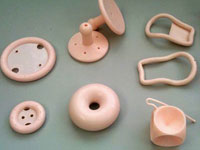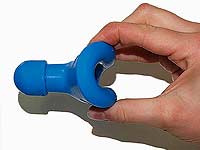Omitting and falling out of the uterus and vagina - an extremely unpleasant disease that can significantly reduce the quality of life of a woman. We will tell about such a method of treating as the use of uterine pessaris, who is shown to install Pessary and what are there any contraindications.
Content
Today, as many years ago, the main method of treating the prolapse of the genital organs is the operation. Doctors unanimously — only she can save a woman from unpleasant, very painful symptoms.
Searches for new methods of surgical treatment continues continuously. If first intervention was traumatic and ineffective, then today new high-tech techniques came to replace. To strengthen the bunch apparatus of the uterus and the pelvic floor, ultra-modern materials are used, the operation has become more secure and gentle. But women still remain, who cannot or do not want to be treated with a radical method.
Uterine pessary as an alternative operation
 Surgical treatment of omission and falling out of the uterus and vagina is undoubtedly the best choice for young women, but pathology is more common in senior age groups, which is due to the invaluing processes occurring in the body of a woman during menopause. Surgical methods for older women are not always acceptable due to accumulated chronic diseases, older patients often refuse the operation in favor of conservative methods.
Surgical treatment of omission and falling out of the uterus and vagina is undoubtedly the best choice for young women, but pathology is more common in senior age groups, which is due to the invaluing processes occurring in the body of a woman during menopause. Surgical methods for older women are not always acceptable due to accumulated chronic diseases, older patients often refuse the operation in favor of conservative methods.
An alternative to the surgical treatment of the female genital prolapse has always been the use of pessary, and today, with the advent of new materials and the invention of new forms, this method is gaining popularity.
In what cases is the installation of pessary?
- In the presence of omitting and falling out of the uterus and vagina, urinary incontinence and with absolute contraindications to the operation due to severe concomitant pathology.
- Categorical failure.
- The need to treat diseases of women's bodies to surgery.
- When it is necessary to predict the results of surgical treatment. In this case, uterine pessar will allow you to demonstrate the results of the operation and evaluate the estimated efficiency.
- To diagnose hidden urinary incontinence, when expressed omitting and loss of genital masks symptoms of incontinence.
In which cases is contraindicated in the installation of pessary?
- With a narrow entrance to the vagina.
- In the presence of precancerous diseases of the cervix and internal genital organs.
- In the uterine bleeding of incomprehensible nature.
- In the presence of an acute sexual tract infection.
- With inflammatory diseases of the pelvis organs.
Contraindications specified in the last three points are relative and overcoming.
Permanent pessary is not recommended for women who cannot attend a doctor once every 3-6 months. Sexually active ladies who do not own the method of installation and removal of pessary, is contraindicated constant use.
What is pessaries and what they happen?
The first attempts to treat the prolapse of Genitals were taken by more hippocratic. As a pessary, he used a grenade sweated in vinegar. Over time, new materials appeared, the forms of Pessariev were improved, to replace primitive «balls» Comedan rings came. At first they were made of wood, corks, impregnated with wax, later from rubber. Modern pessaries only partly resemble their predecessors, these are silicone or polypropylene products, inert to the action of the biological environment of the vagina.
The change in the form of pessary has undergone, their range has expanded. Today you can choose the type of pessary, which most complies with the problem of women.
Pessary on the mechanism of action and form
-
Supporting, which create an additional support by the uterus and warn its omission:
- Pessary-rings (thin uterine rings), fixing on the cervix;
- Thick uterine rings or «donuts»;
- Bed-shaped pessaries with perforations for outflow of vaginal secret and without them;
- Pessary with a levator, intended for the treatment of urinary incontinence;
- Pessary Strips.
- Filling, which filling the volume of the vagina, prevent the provisions of its walls, omitting the uterus, bladder and rectum.
- the same «donut»;
- cubic pessary;
- Inflatable mushroom pessary.
What pessary choose?
 Over the years of scientific and practical search, more than 200 species of pessaris were invented, today doctors use no more than 20 types of products.
Over the years of scientific and practical search, more than 200 species of pessaris were invented, today doctors use no more than 20 types of products.
Choosing Pessary — Priority of the doctor. The form and dimensions of Pessary should maximize the solid problem and the anatomical features of the structure of the genital organs of the woman, to estimate these factors can only a doctor.
Supporting pessarians are recommended when omitting genital organs 1-2, sometimes the 3rd degree. The use of ring pessary with the expressed omitting of genitals is fraught with the uterus through a large hole with subsequent infringement.
With 3-4 degrees of prolapse use a cup of pessaries or pessaries with filling effect. Pessary with a levator are designed to solve the problem of stressing urinary incontinence, often accompanying prolapse.
Some pessaries are designed for permanent use, others require daily extraction and rehabilitation of sex tract. The pessary method is not difficult to master the methodology, but in the absence of such experience, it is necessary to periodically visit the doctor for processing the product and purify sex tract. Some women use pessary only during exercise and visiting public places, at home without him.
In general, the use of pessary — This is a safe and convenient method of treatment of prolapse, which allows many women to live the usual full-fledged life.









